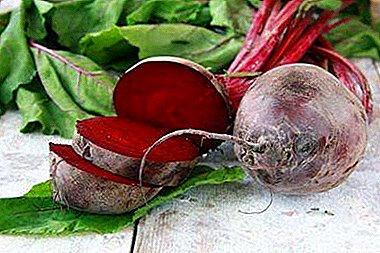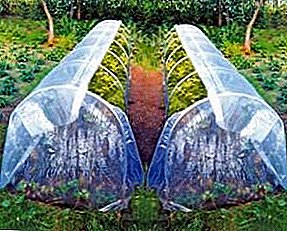
Spider Tick - dangerous pest, destroying both home plants and crops.
In total there are more than a thousand.
However, we will tell only about the most common.
Red
It is found throughout Europe. Hurts indoor plants and greenhouse. In warm areas, it settles on open-field crops. Prefers to eat Solanaceae (potatoes, tomatoes, datura, eggplants), citrus and house plants. How to get rid of spider mites on eggplants, tomatoes and peppers, read on our website.
The adult female has a size of 0.4 mm in length and 0.2 mm in width. Body color - red with a purple tinge. Males are faded, painted in light red tones. The larva is transparent when it begins to eat, it becomes greenish. The nymph is gray, covered with specks.
Red spider mite - photo:

The red mite loves heat more than other varieties. Most suitable temperature for his life - from 30 °. Therefore, it practically does not occur in the open areas of the northern regions. However, in houses and greenhouses time to withdraw more than 20 generations.
We advise you to read our article "Fighting spider mites on indoor plants", which describes all the nuances and features of the destruction of ticks in the house, as well as drugsmost suitable for this.
Ordinary
One of the most dangerous members of the family, is found everywhere, different omnivorous, affecting over 200 plant species. It can produce up to 18 generations per year.
Only by the end of the summer do females change color to a reddish-red one. Eggs are first greenish, then beige, mother of pearl. The larvae are transparent, faded. Nymphs are painted in greyish-green tones.
Optimal living conditions - temperature 28-30 °, humidity 40-50. Harm is caused by all degrees of development, except eggs.
Turkestan
Despite the name, its habitat very extensive. This species is found in Ukraine, all of Central Asia, in Primorsky and Stavropol Territory, Kazakhstan, the Far and Near East, Western Siberia, Europe and North America.
Refers to polyphagous parasites, hitting pome and stone fruit crops, ornamental and leguminous plants.
 The size of adults reaches 0.6 mm, the color is green during feeding, wintering mites turn red.
The size of adults reaches 0.6 mm, the color is green during feeding, wintering mites turn red.
The eggs are first colorless, then yellowish green.
Pale green larvae, nymphs acquire a saturated green-yellow hue, also covered with black specks.
Hawthorn
Inhabits in warm regions Russia, Ukraine, Tajikistan, Armenia, Moldova, Uzbekistan, Georgia, Kazakhstan, Azerbaijan, Western Europe, China, Korea, Japan.
It feeds on fruit crops, both seed and stone fruit. Most common on plum, turn, peaches, apple, sweet cherry, pear, cherry.
Differs in pronounced sexual dimorphism. Females are larger, reach 0.55 mm in length, and males are no more than 0.4 mm. The body color of the females is dark red, the males are green.
Colorless eggs gradually acquire a pinkish - green color. Larvae and nymphs are painted with black spots on a light green background.
Read our article on how to deal with spider mites on raspberries, currants, strawberries and grapes.
False
Heat loving tropic inhabitant. Like all other guests of tropical regions, prefers to live in conditions of high humidity. In Europe, it can only be found on indoor plants and in greenhouses (greenhouses).
Recognizing his attack is very difficult, as this tick does not spin a web. Therefore, the owners of the plants come to life when the pest has already multiplied greatly.
 Differs in small sizes, reaching a maximum of 0.3 mm in length.
Differs in small sizes, reaching a maximum of 0.3 mm in length.
It has an ellipsoid body, painted in red or green.
To discover it experienced growers are advised to hold a white napkin on the inside of the leaves.
Cyclamen
Another guest from the tropics. Loves heat, is not afraid of moist air. Throughout Europe, can only live in homes and greenhouses. Monophage eats cyclamen, can settle on chrysanthemum, balsamic vine, gloxinia and geranium. The rest of the plants can not be afraid of him.
It has a very small size (0.1 - 0.2 mm), an oval body of a dull color. May be greenish or yellow. A pest colony is most often collected in the upper half of the leaf. Large tick aggregations look like dust.
Gallic
Common everywhere, even shrubs and trees damage. Settles on young leaves, during feeding, forms bloating on them - galls.
The body is elongated, shaped like a spindle. The color is off-white or brown.
Wide
A resident of South America, the most common in Europe in homes and indoor spaces. He prefers citrus fruits, euonymus, cacti, oleander, ficus, saintpaulia, aucuba, taghetis.
 Treats easily removed wreckers as eggs are always on leaves, do not hide in hard-to-reach places.
Treats easily removed wreckers as eggs are always on leaves, do not hide in hard-to-reach places.
Microscopic dimensions - not more than 0.3 mm.
The little body is oval, brown color with a red shade.
Inhabits on the lower surface of the leaves.
Root (bulbous)
You can meet everywhere. Settled inside the bulbs colors and feeds on their tissues. Such an onion turns into dust. To detect pests can only dig a plant from the ground.
The body has the shape of an oval, extended in the sides, the size reaches 1.5 mm in length. The color is faded - pale yellow or dirty - white.
Omnivorous, strong voracity, high fecundity mark spider mites as pest family various cultivated plants. But experience shows that it is quite possible not only to fight with them, but also to win.
Therefore, do not fold your hands, get acquainted with the materials of our site that will help in difficult fight with arachnoid parasite and all you get! This will help you our article "Methods and measures to combat spider mite."












